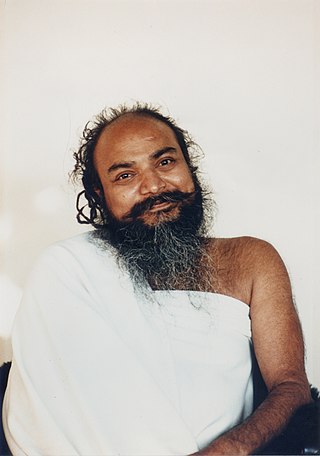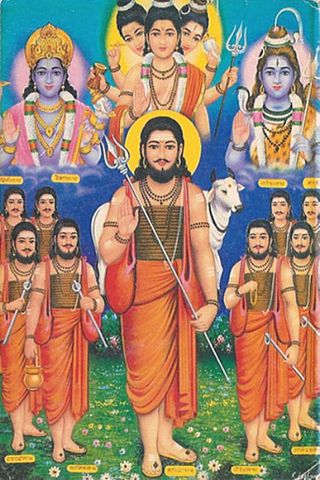
Ramana Maharshi was an Indian Hindu sage and jivanmukta. He was born Venkataraman Iyer, but is mostly known by the name Bhagavan Sri Ramana Maharshi.

Nisargadatta Maharaj was an Indian guru of nondualism, belonging to the Inchagiri Sampradaya, a lineage of teachers from the Navnath Sampradaya.

Jnana yoga, also known as the jnanamarga, is one of the three classical paths (margas) for moksha (liberation) in Hinduism, which emphasizes the "path of knowledge", also known as the "path of self-realization". The other two are karma yoga and bhakti yoga. Modern interpretations of Hindu texts have yielded systems, techniques and formulations such as raja yoga and kriya yoga.
Śrĩ Atmananda, also referred as Sri Atmananda Krishna Menon, was an Indian sage, guru, and philosopher. He has been described by scholars as a "neo-Hindu". His teachings have become a foundation for a spiritual method called the Direct Path.

Dāsbodh, loosely meaning "advice to the disciple" in Marathi, is a 17th-century bhakti (devotion) and jnana (insight) spiritual text. It was orally narrated by the saint Samarth Ramdas to his disciple, Kalyan Swami. The Dāsbodh provides readers with spiritual guidance on matters such as devotion and acquiring knowledge. Besides this, it also helps in answering queries related to day-to-day life and how to find solutions to it.
Maurice Frydman, aka Swami Bharatananda, was an engineer and humanitarian who spent the later part of his life in India. He lived at the ashram of Mahatma Gandhi and took an active part in India's fight for independence—notably in helping to draft a new constitution for the State of Aundh that became the Aundh Experiment. He was a Polish Jew who subsequently converted to Hinduism.

Self-enquiry, also spelled self-inquiry, is the constant attention to the inner awareness of "I" or "I am" recommended by Ramana Maharshi as the most efficient and direct way of discovering the unreality of the "I"-thought.

Sri Siddharameshwar Maharaj (1888–1936) was a guru in the Inchagiri Sampradaya founded by his guru Bhausaheb Maharaj, a branch of the Navnath Sampradaya, the 'Nine Masters' tradition in India. His disciples included Nath teachers Nisargadatta Maharaj, Ranjit Maharaj, Kaadsiddheshwar, and Ganapatrao Maharaj Kannur.
The term subitism points to sudden awakening, the idea that insight into Buddha-nature, or the nature of mind, is "sudden," c.q. "in one glance," "uncovered all together," or "together, completely, simultaneously," in contrast to "successively or being uncovered one after the other." It may be posited as opposite to gradualism, the original Buddhist approach which says that following the dharma can be achieved only step by step, through an arduous practice.

The Navnath, also spelt as Navnatha in vernacular languages, are the nine saints, Masters or Naths on whom the Navnath Sampradaya, the lineage of the nine gurus, is based. They are worshipped collectively as well as individually.

Shri Shivabalayogi Maharaj was a yogi who claimed to have attained self-realization through twelve years of arduous tapas, meditating in samādhi for an average of twenty hours a day.

Shri Samarth Muppin Kaadsiddheswar Maharaj was a guru in the Navnath tradition of Hindu philosophy. He was a disciple of Shri Samarth Siddharameshwar Maharaj, disciple of Shri Samarth Bhausaheb Maharaj, disciple of Shri Gurulingajangam Maharaj, disciple of the 22nd Shri Samarth Muppin Kaadsiddheswar Maharaj.

Jangama dhyana is a meditation technique which has been practiced by various sages over the centuries. In recent times, this technique was widely taught in India and around the world by Shri Shivabalayogi Maharaj, who experienced a spiritual vision in which the manifestation of a Jangama sage instructed him in this technique of meditation to achieve self-realization. Jangama means 'eternal existence' and dhyana means 'meditation.' Hence Jangama dhyana is 'Meditation on the Eternal Existence .'

The Advaita Guru-Paramparā is the traditional lineage (parampara) of divine, Vedic and historical teachers of Advaita Vedanta. It begins with the Daiva-paramparā, the gods; followed by the Ṛṣi-paramparā, the Vedic seers; and then the Mānava-paramparā, with the historical teachers Gaudapada and Shankara, and four of Shankara's pupils. Of the five contemporary acharyas, the heads of the five Advaita mathas, four acharyas trace their lineage to those four pupils and one to Adi Shankara himself.
According to Sarira Traya, the Doctrine of the Three bodies in Hinduism, the human being is composed of three shariras or "bodies" emanating from Brahman by avidya, "ignorance" or "nescience". They are often equated with the five koshas (sheaths), which cover the atman. The Three Bodies Doctrine is an essential doctrine in Indian philosophy and religion, especially Yoga, Advaita Vedanta, Tantra and Shaivism.

The Inchagiri Sampradaya, also known as Nimbargi Sampradaya, is a lineage of Hindu Navnath and Lingayat teachers from Maharashtra which was started by Bhausaheb Maharaj. It is inspired by Sant Mat teachers as Namdev, Raidas and Kabir. The Inchagiri Sampradaya has become well known throughout the western world due to the popularity of Nisargadatta Maharaj.

Robert Adams was an American Advaita teacher. In later life Adams held satsang with a small group of devotees in California, US. He mainly advocated the path of jñāna yoga with an emphasis on the practice of self-enquiry. Adams' teachings were not well known in his lifetime, but have since been widely circulated amongst those investigating the philosophy of Advaita and the Western devotees of Bhagavan Sri Ramana Maharshi. A book of his teachings, Silence of the Heart: Dialogues with Robert Adams, was published in 1999.

Bhausaheb Maharaj was the founder of the Inchegeri Sampradaya, to which the well-known Indian guru Nisargadatta Maharaj belonged.

David Godman has written on the life, teachings and disciples of Ramana Maharshi, an Indian sage who lived and taught for more than fifty years at Arunachala, a sacred mountain in Tamil Nadu, India. In the last 30 years Godman has written or edited 16 books on topics related to Sri Ramana, his teachings and his followers.















